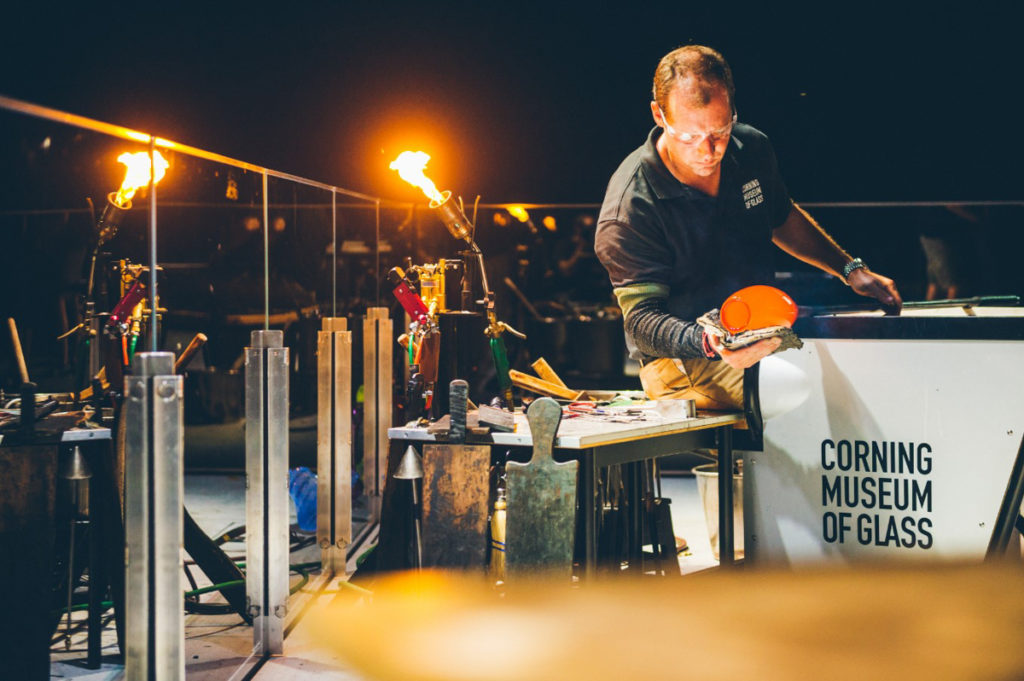How long have you been at the Corning Museum of Glass?
I started more than 20 years ago when I was in college in 2002. I’m a glassmaker by trade, and I really enjoy the frontline work and conducting glassmaking demonstrations. It has been exciting to progress and now plan exhibition-related programming with guest artists and curators.
We have a unique opportunity to showcase how the work on view has been created with our glassblowing demonstrations. We have six full-time glassmakers who start with a glob of molten glass and turn it into an object for the museum’s visitors. While I deal primarily with the public, the museum also has a separate set of programs dedicated to education and the teaching of these skills.
What was your involvement with “Dig Deeper: Discovering an Ancient Glass Workshop” [an exhibition opening in May], which presents new findings from a 1960s excavation of a 4th-century glassmaking and blowing workshop in Jalame, Israel?
I believe there’s only one complete object from that site. There are a lot of castoffs and scrap fragments, however, that have been collected. The show’s curator, Katherine Larson, wanted to understand more about those objects—where they came from and how they came about—and, in turn, what they can tell us about how the objects were made.
We built an ancient-style furnace so that we could try to replicate the processes that would have occurred in the Jalame workshop. We consulted some artists in England who have been reconstructing Roman-style furnaces for the last six or so generations. The stoves themselves exist on a personal scale—not like the large furnaces we typically work on today. The stoves are made of clay and [the organic material] daub, and they look like a dome. They are built like a coil pot and burn wood. The whole design of these ancient stoves is based on one depiction from a tiny oil lamp. It took us about three to four months to construct.
We did a test run in spring 2022 to understand the logistics of working with the stove. Since our relationship to our workspace shifted with the use of a smaller stove, it changed the entire glassmaking process. A zigzag pattern at the bottom of one ancient piece that proved nearly impossible to replicate in our modern furnace was suddenly possible. Learning something new made the whole process worth it. For public programming coinciding with the exhibition, we plan to rebuild the furnace with more durable modern materials.
What do you most look forward to in a project?
I enjoy collaborating with artists who don’t typically work in glass. The Native American ceramic artist Virgil Ortiz, for example, worked with our team to create glass objects that picked up visual elements from his ceramic sculptures. We also worked with Virginia Overton to create glass works for her 2022 Venice Biennale installation. Partnerships like these really push the creative and sculptural possibilities of glass. We have a similar program for designers as well.
What changes do you see in the field of glassmaking?
A lot of the creative energy and talent in glassmaking right now is because of the proliferation of incredibly intricate smoking devices. The museum has a marijuana pipe in its collection, as well as a recurring program every January where we collaborate with flame workers to make something that’s greater than the sum of its parts. It’s easy to dismiss, but there has been a huge expansion of techniques, skills, and refinement over the last 10 years due to the rise of the cannabis industry. Pipes are functional objects, and while we don’t know how they will be represented in the future, they’ve revitalized the field.
Glass is also essential to modern technology. Optical fiber, which is a thread of glass, is used to make phone and computer screens. You can’t transmit data fast enough to have a video conference without glass. All of that is made by Corning Incorporated, which started in decorative glass and founded the museum.
H/T: www.artnews.com




